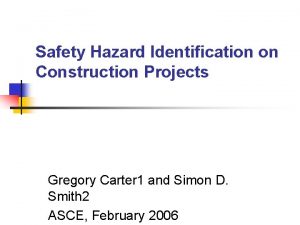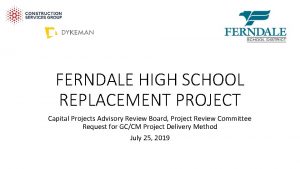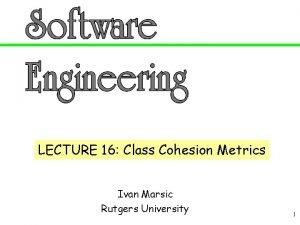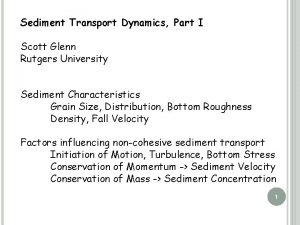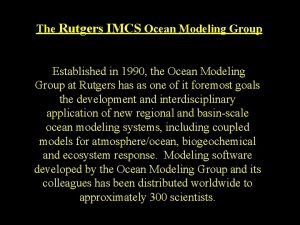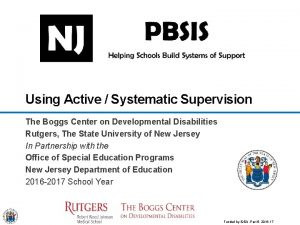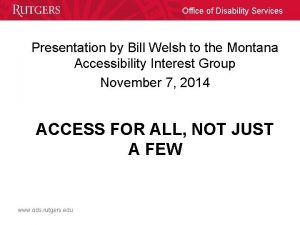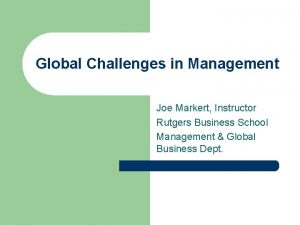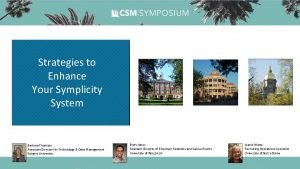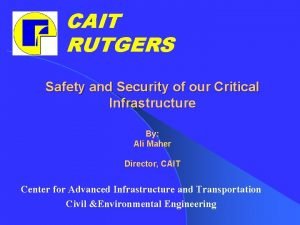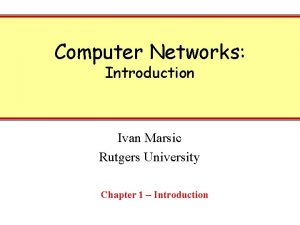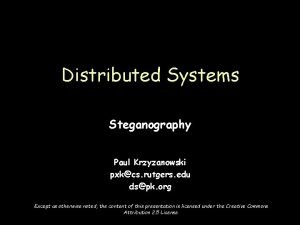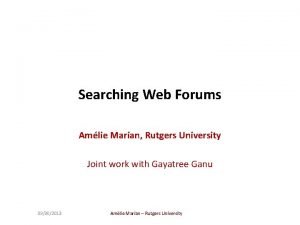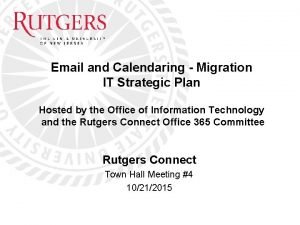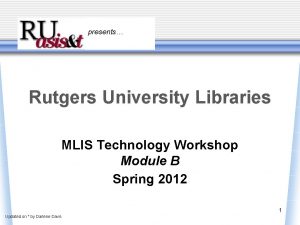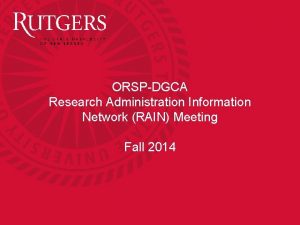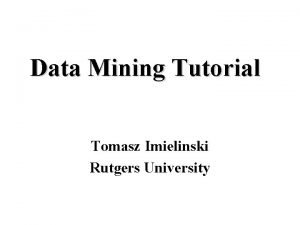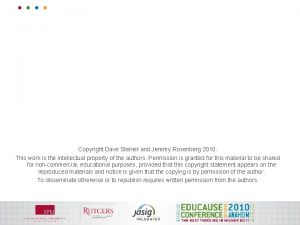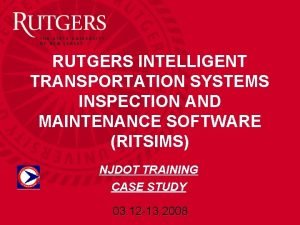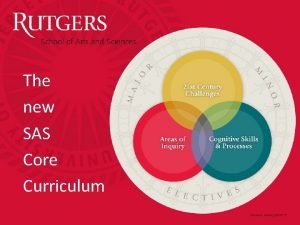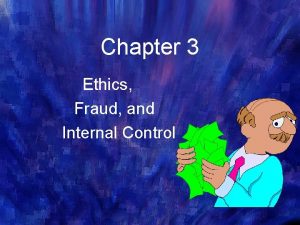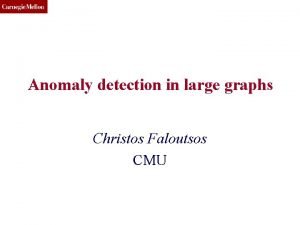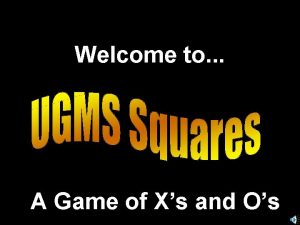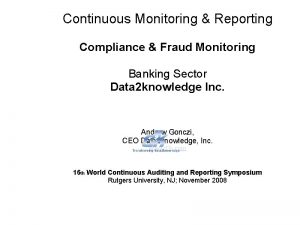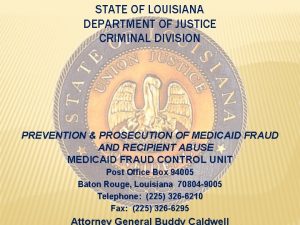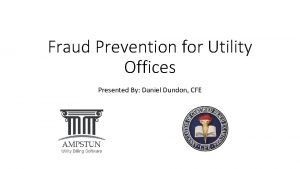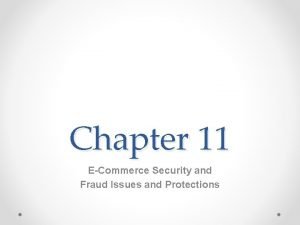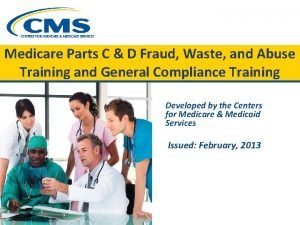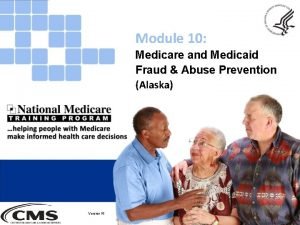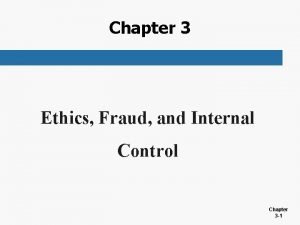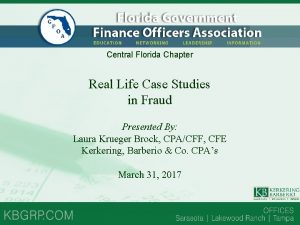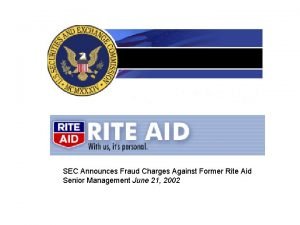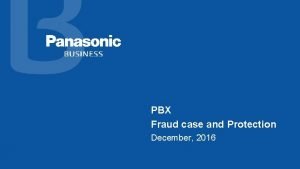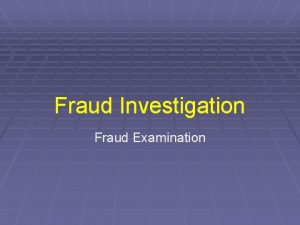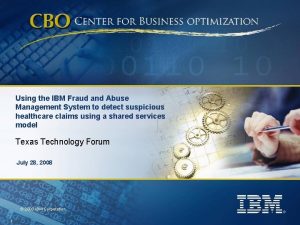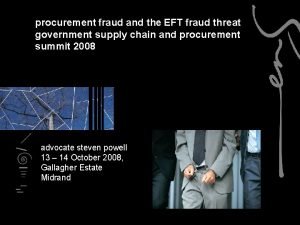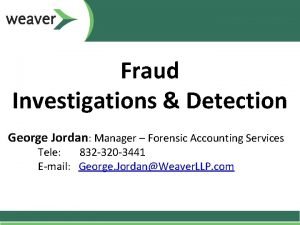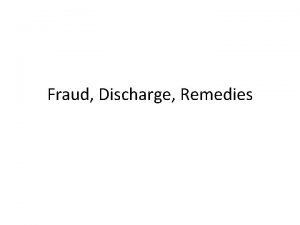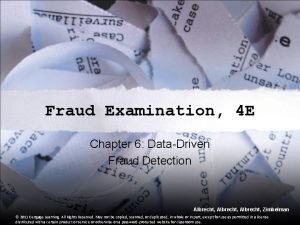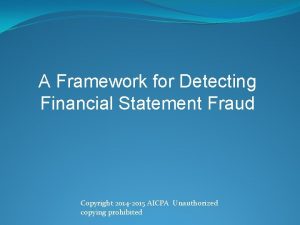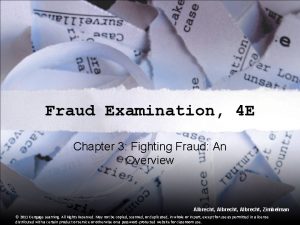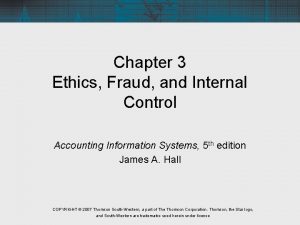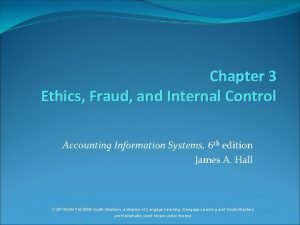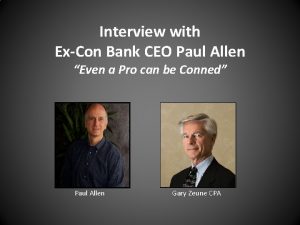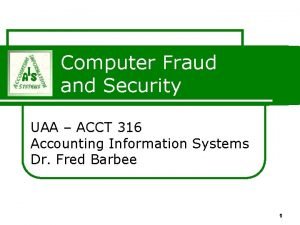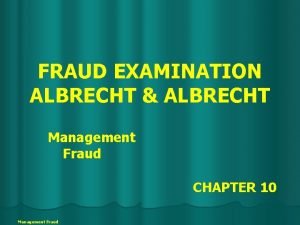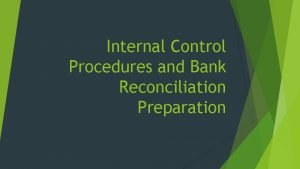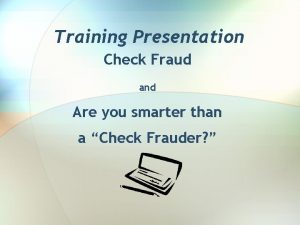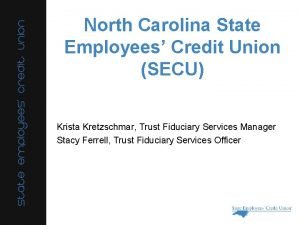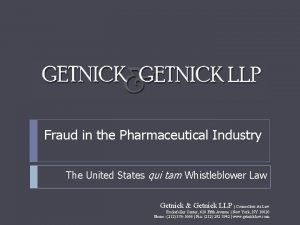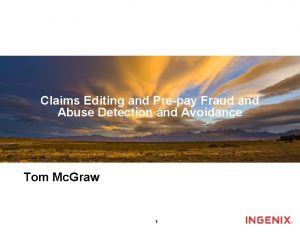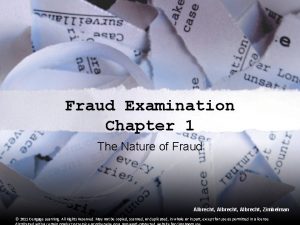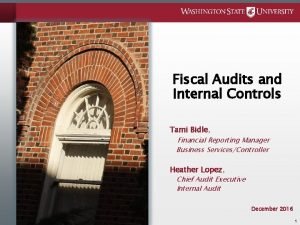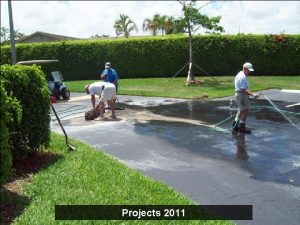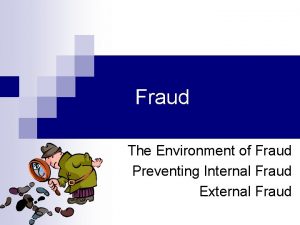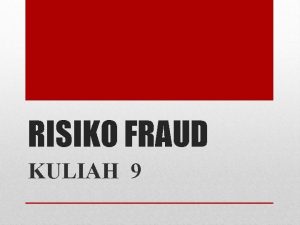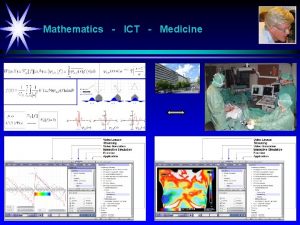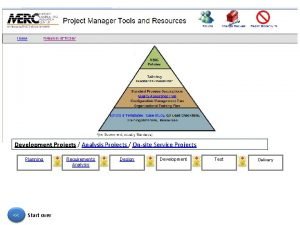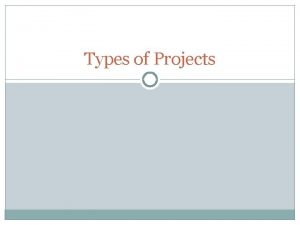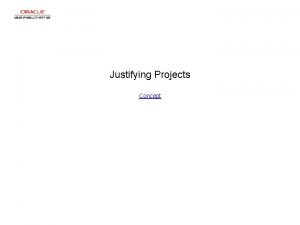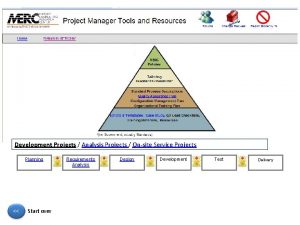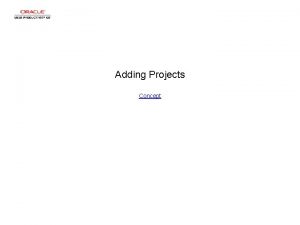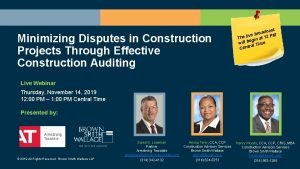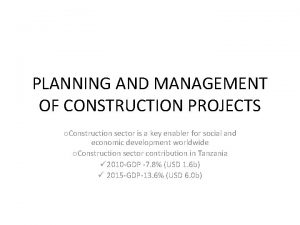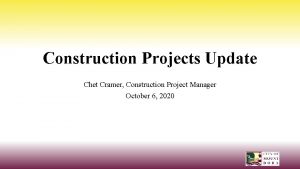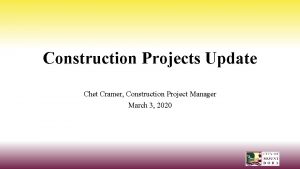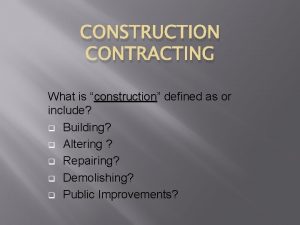Rutgers 17 th Fraud Seminar Fraud Construction Projects










































































































- Slides: 106

Rutgers 17 th Fraud Seminar Fraud – Construction Projects Thomas Palczewski Director, Internal Audit TPalczewski @ NJTransit. com 973 -491 -7848

Introduction Course objective: To demonstrate an audit approach designed to identify construction fraud, project cost recoveries and also provide insight to the mindset and necessary skills an auditor must have in order to successfully perform a construction audit.

Safety Briefing Every job on a Construction Project Usually Starts with a Safety Briefing.

Safety Briefing Do Not Do This

Safety Briefing Do Not Do This

Safety Briefing Do Not Do This

Safety Briefing Do Not Do This

Safety Briefing Do Not Do This

Safety Briefing Do Not Do This

Safety Briefing Do Not Do This

Safety Briefing Do Not Do This

Safety Briefing Do Not Do This

Safety Briefing Do Not Do This

Safety Briefing Do Not Do This

PRACTITIONER’S BLUE PRINT TO CONSTRUCITON AUDITING THE RON RISNER, CIA, CCP IIA RESEARCH FOUNDATION

Giovanni Arnolfini And His Bride by Jan Van Eyck - 1434

Gather Evidence Visual Observation – Most Basic way to gather evidence. Examine Records – Often accepted as statements of fact. Sample Evidence – Does not need to be statistically based but should be representative (reasonable). Record Notes – Only one chance to capture the details of evidence. Source: Craig Cochran – Techniques for Gathering Evidence

FOR IMMEDIATE RELEASE Wednesday, August 2, 2017 Owners Of Hudson County, New Jersey, Scrap Metal Company Charged With 17 -Year Conspiracy To Defraud Customers Former Chief Financial Officer Has Pleaded Guilty to Related Charge NEWARK, N. J. – The owners of ABC Iron & Metal Co. were arrested today and charged with operating a 17 -year conspiracy that defrauded customers out of millions of dollars, Acting U. S. Attorney William E. Fitzpatrick announced. According to documents filed in this case and statements made in court: ABC Iron & Metal Co. which was headquartered in Secaucus, New Jersey, purchased scrap metal for resale and operated three scrap metal recycling facilities in New Jersey. ABC Iron & Metal Co. trucks would deliver scrap metal containers to customer jobsites and remove them after they were filled. ABC Iron & Metal Co. then purportedly paid customers based on the type and net weight of the scrap material. From 1999 through March of 2016, Jim, Frank and Sam and others allegedly used a variety of fraudulent business practices to buy scrap metal from ABC Iron & Metal Company’s customers for less than ABC Iron & Metal Co. should have paid. The company then resold the scrap metal at a profit. Instead of paying the proper, agreed-upon amounts for the actual weight, members of the conspiracy used a variety of techniques to misrepresent the true weight and type of the scrap metal, including altering documents to reflect a lower weight, removing scrap metal from a haul before it was weighed and misrepresenting the types of scrap metal contained in a haul.

Example of Cable

Project Management KPMG Service: Advisory, Risk Consulting, Forensic Type: Survey report Date: 10/8/2013 Although the engineering and construction industry has made great strides in managing risk, 77 percent of respondents report underperforming projects, due primarily to delays, poor estimating and failed processes. http: //www. kpmg. com/global/en/issuesandinsights/articlespublications/globalconstruction-survey/pages/minimizing-potential-for-failure. aspx

Project Management

Project Management

Project Management

Project Management

Project Management

Project Management

Project Management

Project Management

Project Management

Project Management KPMG Service: Advisory, Risk Consulting, Forensic 10/8/2013 Main Causes of Underperforming Projects: 51% Project Delays 50% Poor Estimating Practices 47% Failed Risk Management Process 37% Poor Subcontractor Performance 36% Design Errors and Omissions 20% Lack of Available Resources 17% Change In Project Management 16% Poor Client Relations

Project Management Goal: Risk: Design a plant that meets required goals. Architect design exceeds requirements and project is over budget. (Whales) Goal: Design and Build the World Trade Center Transportation Hub. Risk: Design Changes result in excessive costs. New York Times - Cost swell to $4 Billion. (NYC) www. nytimes. com/2014/12/03/nyregion/the-4 -billion-train-station-at-the-world-tradecenter. html? action=click&content. Collection=Opinion&module=Most. Emailed&version=Full&re gion=Marginalia&src=me&pgtype=article

Project Management Example of Business Planning Risk: Goal: A project is fast tracked in order to bring a new product to market. Risk: FDA delays approval of new product. (Italy) Risk: Unique equipment is not available upon completion of construction. (Ireland) Risk: Owner changes their mind. (Massachusetts) Goal: Risk: Construct a new plant in order to expand capacity. During construction, capacity requirements change and a new plant is not required. Plant under-utilization is a major concern. (Ireland - Puerto Rico)

Contracts

Contracts Guaranteed Maximum Amount (GMA) Guaranteed Maximum Profit (GMP) Owner hires a Construction Manager (CM) • The Owner reimburses the CM for incurred costs (General Conditions / Contractors / Suppliers. • CM Profit is limited to an agreed upon fee (percentage). The CM fee is applied to the CM incurred project costs. • The actual GMA amount is typically not finalized until the majority/significant subcontractor or supplier bids have been received.

Project Funding • The Owner must approve Project Funding (CAR). • The project should be managed to the GMA Amount plus a reasonable contingency, not the Project Funded Amount. • A reasonable Contingency should be included within the Project Funding.

Demolition and Restoration Project Background: ABC company entered into GMA construction agreements with Toms Construction to perform demolition and restoration at a facility located in California. The demolition and construction was required to return a leased facility back to the landlord based on the terms of the lease. The GMA contracts were executed and managed by an ABC Project Manager. As the restoration project was coming to a completion, the ABC Project Manager and ABC Facilities Management were severed from the company as a result of the closure of the ABC business.

Demolition and Restoration Project The Project Manager, on his last day, drove to the construction site in his new yellow corvette and dropped off $587, 000 of unsupported change orders. The Regional Manager of ABC California Site Operations became responsible for project close out. The Regional Manager noted that project documentation did not adequately support the invoices and change orders submitted for payment. As a result, Corporate Internal Audit was requested to assist in reconciling the amount to be paid to Toms Construction.

Demolition and Restoration Project GMA: Interior Demolition - $ 865, 000 GMA: Restoration - $ 1, 920, 000 Total - $ 2, 785, 000 All work was paid under Firm Fixed Contracts Modifications / Change Orders: • Demolition - $240, 000 • Restoration - $347, 000 • Total - $587, 000 Under a GMA contract, the Construction Manager is paid for costs incurred up to the amount of the GMA / GMP plus an agreed upon fee. 1 st Step: Confirm Costs Incurred.

Demolition and Restoration Project • Request Toms Construction to provide cancelled checks paid to contractors. • 2 nd Step – Agree Toms Company payments (cancelled checks) to subcontractors to the amount Toms Company invoiced to ABC Company. Results: • Toms Construction provided Audit with “Contractors Release From Lien”. Cancelled checks were not provided. • 3 rd Step – Inform Toms Construction that outstanding payments and retention will not be paid until all records are reconciled.

Demolition and Restoration Project Total Toms Construction Billings to Project: $2, 785, 000 Toms Company provides Audit with cancelled checks: $1, 170, 336 Missing Costs allegedly incurred: $1, 614, 664 Toms construction could not account for $1, 614, 664 of Billings to ABC Company. $800, 000 could not be matched to specific line items (Paint, Sheetrock and Carpentry).

Demolition and Restoration Project 4 th Step – Obtain subcontractor invoice for Paint, Sheetrock and Carpentry. Results: Toms Company did not provide subcontractor invoices. Instead, subcontractor bid quotations were provided. • Subcontract work was not competitively bid. Bid quotations do not provide evidence that work was performed. • Toms Company admitted that they obtained high bid quotations and then self performed the work. • It is a best practice that Construction Managers (Toms Company) not self perform work.

Demolition and Restoration Project • Auditing could not determine the actual cost incurred by Toms Company to perform paint, sheet rock and carpentry work. 5 th Step: Verify cost of Change Orders $587, 000: • Previously, Toms Company provided Vendors Release From Lien. • The Release from Lien’s indicated that the outstanding balance for Electric and Plumbing work was $230, 000. • $357, 000 of the Change Orders represents costs that were not incurred. Documentation did not provide adequate evidence to justify the $230, 000 for outstanding Change Orders.

Demolition and Restoration Project Other Concerns: • Toms Construction overstated their management fee by $230, 144. • Duplicate payments of $22, 048 were identified. • Project incurred $34, 500 in Building Code Improvements which were not contractually required. • Competitive sealed bids were not obtained. • No evidence of ABC Company Project Management review and approval of award of work to subcontractors or suppliers.

Demolition and Restoration Project • Self performed work by the General Contractor should only be allowed on an exception basis, with prior approval by the Owner and reasonableness of cost be clearly documented. • Project related documentation provided no evidence that work was actually performed. Each scope of work should be approved prior to payment.

Demolition and Restoration Project • Toms Construction project billing was not prepared in the required contractual format. Toms Construction billed the project as a lump sum contract. As a result, the project was billed for the total agreed upon GMA plus Change Orders. • The process used to monitor and approve Change Notices lacked the following controls: • Change Notices were not prepared in the required format. • Approval of Change Notices was not documented. • A Change Notice Control Log was not maintained. • The reasonableness of the Cost of Change Notices was not documented or approved.

Demolition and Restoration Project Acceleration Payments: Three Change Notices identified acceleration charges totaling $166, 600. Although Project Management approved the acceleration of work, project documentation does not provide evidence that the acceleration costs were actually incurred. In this case the cost of acceleration charges should be limited to the premium portion of overtime hours paid.

Construction Management General Conditions

Construction Management General Conditions represent Indirect Project Costs that are necessary to complete a project: Example: – – – – – Construction Management Personnel Employee Reimbursables Temporary Site Facilities and Equipment Work location / Furniture / Computers General Labor Rentals / Small Tools Allowances Insurance Bonds

Construction Management Completion Concerns: – Is the work schedule in agreement with the completion date? – Have project milestones been identified? – Is there a method of determining the value of work performed? – Is the value of work performed in agreement with milestones?

Construction Management • The Owner should pre - approve in writing all Construction Management people and their wages who will charge the project. • Construction Management personnel such as Directors and Home Office personnel are generally not billable to the project. • A Man Power Curve identifies the time frame and number of Construction Management people who will charge the project. The Man Power Curve should be approved by the Owner. • For Budgeting purposes it is necessary to ensure that the Man Power Curve is adhered to.

Construction Management • A Budget should be established for each Construction Management Person approved to charge the project. This budget should utilize the Construction Management Persons agreed upon burdened rate and duration on site as identified within the Man Power Curve. • It is preferred that Construction Management Billings identify each employee, their approved budget, the current and project to date expenditure and percentage spent. • Daily work day hours must be established.

Construction Management The Owner reimburses the CM for incurred costs. Examples of Construction Management overcharges (non- incurred costs): • The CM does not pay overtime to employee’s, but overtime hours are charged to the project. • A CM employee is billed to the project for an amount in excess of what the employee is paid.

Construction Management Tracking Hours Worked: • A reliable method of tracking CM employee hours worked (Gate Pass, Key Card System, Time Sheets, etc. ) should be implemented. • Without a reliable tracking system, actual hours worked cannot be determined.

Construction Management • Verify accuracy of Hours Worked and Hourly Rates for each CM employee charged to the project. This is accomplished by agreeing: • Hours worked per time tracking system to (1) hours charged to the project and (2) CM payroll documentation. • If only time sheets are utilized, evaluate the process used to ensure their accuracy. • Verify whether overtime or premium hours is an allowable project charge.

Construction Management Typical CM Payroll Overhead Rates: – – – Social Security Health Insurance Vacation Holidays Sick Pay – Company Allowance Retirement Plan – Company Contribution Savings Plan – Company contribution Insurance Company Contribution Federal / State Unemployment Insurance Bonuses / Supplemental Compensation (Annual) Worker’s Compensation Safety / Development Training

Construction Management Payroll Overhead: • The CM must recover the cost of employee Payroll Overheads. Therefore the cost of each CM employee is comprised of their hourly rate (Unburdened Rate) plus an amount to recover the cost of employing that persons overhead cost (Burdened Payroll Rate). • Payroll Overhead charges and rates should be identified prior to award of contract to CM. Best practice is to verify these rates prior to award or early in the construction process.

Construction Management Payroll Overheads: • Allowable CM Payroll Overheads should be identified. All other CM payroll Overheads should be included in the agreed upon CM Management Fee. Payroll Overheads are not to be a profit center for the CM.

Construction Management Trade: Cost: 6. Current Maximum Fringe Benefit Cost for Salaried Employees: COMPONENT % OF BASE SALARY a) Social Security b) Health Insurance c) Vacation d) Holidays e) Sick Pay-Company Allowance f) Retirement Plan-Company Contribution g) Savings Plan-Company Contribution h) Insurance-Company Contribution i) Federal/State Unemployment Insurance j) Bonuses/Supplemental Compensation (Annual) k) l) NOTE: Worker's Compensation Safety/Development Training (2 d/Mo Max) Hours paid with prior app'l of PM Total Fringe Benefit Cost 0% Fringe benefit costs are to include all payroll related taxes. Fringe benefit costs are subject to audit. The above fringe benefit component list is a representative sample. Add or delete components as appropriate.

Construction Management • A separate and reduced Payroll Overhead Rate should be identified and approved for CM Contracted Employees. • If the CM Payroll Overhead is overstated, the project will be overcharged because the CM did not incur these costs. • Most Payroll Overheads should not be applied to Premium Hours.

Construction Management Examples of Excessive CM Overhead Charged To The Project Some Items May Be Specific To The U. S. Example – Social Security: The CM bills for FICA beyond the established taxable salary for each employee. Example - Health Insurance: CM Health Insurance costs are charged for CM employees who are not eligible or do not participate in the CM Health Care Program. Total cost of Health Care is overstated. Example – Vacation: CM employees are not eligible to receive CM vacation benefits. CM Vacation Payroll Overhead Rate overstates the number of vacation weeks employees are entitled to receive.

Construction Management Examples of Excessive CM Overhead Charged To The Project: Some Items May Be Specific To The U. S. Example - Holidays: The CM Holiday Payroll Overhead Rate is applied to CM Contracted employees or is not consistent with holidays that the CM provides to their employees. Example – Sick Pay: The CM Sick Payroll Overhead Rate exceeds the actual sick days used by CM Employees or is applied to CM contracted employees. Example – Retirement / Savings Plan: Not all CM employees participate in the Retirement / Savings Plans.

Construction Management Examples of Excessive CM Overhead Charged To The Project: Some Items May Be Specific To The U. S. Example – Federal / State Unemployment Insurance: Unemployment Insurance is charged beyond the Federal or State mandated cut off amount. Example - Bonuses / Supplemental Compensation (Annual): CM Payroll Overhead Rate for bonus is less than bonus amount paid to CM employees.

Construction Management Examples of Excessive CM Overhead Charged To The Project Some Items May Be Specific To The U. S. Example – Workers’ Compensation: Workers’ Compensation is charged at a rate that exceeds the actual CM cost (8% vs. 4%). Also, the rate charged for Worker’s compensation may be applied to the burdened employee rather than the unburdened rate. Example - Safety / Development Training : CM employees do not incur the amount of training included in the overhead rate charged to the project.

Employee Reimbursables Typical CM and A/E employee expenses may include: – – – – Housing Airfare Meals Cell Phone Car Rental / Lease / Taxis / Mileage Laundry Household Supplies

Employee Reimbursables Unless a prior agreement has been established, reimbursement of CM or A/E employee expense typically follows the CM or A/E Reimbursement Policy. Prevent problems before they occur – gain agreement in advance… Who can charge? What can be charged? What billing format is required? Who approves at the contractor and Owner level? What supporting documents are required?

Employee Reimbursables Administration of CM or A/E employee expenses can be time consuming and difficult to administer. Multiple expense reports per employee may result in: – Duplicate Charges – Missing receipts – Unauthorized upgraded flights or hotels – Math Errors – Unauthorized Meals – Car lease (who is authorized) Where applicable, the use of per diems is encouraged.

Temporary Site Facilities and Equipment – Typically Include: Trailer – mobilization / de-mobilization Furniture / Office Supplies Lap Tops / Printers Copies / Copiers Project Signs Telephones Electric / Electric Connections Toilets Sidewalks Parking Water Cars

Temporary Site Facilities and Equipment • A budget should be established for each of the costs to be charged to the project. • Reimbursement of each cost must be incurred. Receipts should be required. • The items purchased remain the property of the Owner. • Items considered to be a fixed asset should be recorded and tracked with a fixed asset number. • Expenditures should take place as required throughout the project. • Unspent line items should not be spent unnecessarily.

Temporary Site Facilities and Equipment • Unspent line items should not be transferred to another line item. • Large items such as trailers and labor, etc. , should be competitively bid. • Labor rates and overheads should be verified. • On a sample basis, CM should provide evidence (cancelled checks) of costs incurred.


Rental Equipment & Small Tools Contractor Owned Equipment Rental Charges: • The use of Rental equipment and rates must be approved in advance by the Owner. • The rate cannot exceed 75% of the rate published by Associated Equipment Distributors for Contactor Owned Equipment Rentals • Total rental should not exceed 60% of the fair market value of equipment. Third Party Equipment Rentals: Total rental cannot exceed the fair market value of equipment at the time of rental.

Rental Equipment & Small Tools • Routine maintenance and minor repairs may be charged to the project. Major repairs are not allowable. • Ensure that rentals are returned in a timely manner. • Be aware of any rentals that may be covered under a lease purchase agreement. • Any rental rebates received by CM should be reimbursed to the project.

Rental Equipment & Small Tools • Small Tools and Consumables should be defined. • Charged at actual cost or as a % of labor or contract amount. • Small tools and consumables should not be a CM profit center. • Ensure double billing of small tools or consumables does not occur.

Material • Ensure that Contractor bills for material at actual cost. • Ensure that project is not billed for quantities that exceed amount actually required / used. • Ensure that credit is received for unused or reusable items. • Ensure that material meets required specifications. • Ensure that material is secure.

Allowances • Allowances may or may not be part of the General Conditions. • Instances may occur where the expense for certain line items has not been identified. When this occurs, an allowance or an estimated amount is identified and included within the GMA. • Ideally, Allowances should not be encouraged.

Allowances • The actual value of the line item in which an Allowance has been assigned must be approved by the Owner prior to the expense being incurred. • Allowance funding in excess of actual cost is not included within the GMA. • Only incurred costs are reimbursed. • Internal Labor should be monitored.

Accounting Controls Invoice Approval

Invoice Approval • The accuracy and validity of the CM invoice depends on the CM’s invoice preparation process. • Meet with the CM and evaluate how the CM ensures that each charge is accurate and valid. Example: What process exists to ensure that: • Hours were actually worked. • All hourly rates are correct. • No duplicate charges • Percentage completion of subcontract work is accurate. • Etc.

Invoice Approval Review the contractor’s procedures • How are charges generated? • Who reviews and approves charges/invoices? • What is reviewed? • What has the past history with this contractor been like?

Invoice Approval The standard GMA Contract should specifically identify and require the invoice format to be used by the CM. No Exceptions. (AIA – Architect Institute of America) The following slide provides an example of the Standard Invoice Format:



Project Invoice Review Owner review of invoice must include: • Mathematical Accuracy • Invoice includes necessary receipts. • Verification that costs were actually incurred and allowable per contract. • Proof of subcontract work performed

Project Invoice Review • Owner’s representative should perform a Pencil Review of the invoice. Identified errors should be corrected prior to submission for payment. • Do not withhold invoice from payment for minor errors. • Maintain a list of items to be corrected on next invoice. Do not allow noted errors to remain open for a lengthy period of time. • Invoice should be approved by both the CM and the Owner. Actual approvers should be identified within the contract.

Bonds Should a project require Bonding. • Does the Owner wish to obtain a performance bond? • What is the criteria for making this decision? • Decision to bond will vary by location, project needs and economic conditions. Sub. Guard: • Insurance Policy obtained by the CM. • Sub. Guard may involve significant rebates. • Sub. Guard is not recommended because it covers the entire project.

Project Controls Staff Charges: ü Owner approves all CM staff prior to working on or charging the project. ü Owner approves CM hourly rates. Reasonableness of CM hourly rates is documented. ü CM Home Office charges are limited to specific pre approved items (Computer Support). ü Home office directors do not charge the project. Owner must approve exceptions in advance. ü Manpower curve is developed and tracked. ü A specific overtime policy has been implemented. ü A reliable time tracking process has been implemented. ü Owner verifies that hours charged were actually incurred and charged at the agreed upon rate. ü Owner verifies that CM employees are paid the rate billed to project. ü Owner approves in advance the annual CM raises and bonuses.

General Conditions Summary Payroll Overheads : ü A/E's and CMs typically charge a fixed rate to each employees salary for employer payroll overheads costs such as Healthcare, vacation, sick days, 401 K matching, etc. ü Owner identifies allowable payroll overhead charges. Non allowable payroll overhead charges are not included in the Payroll Multiplier. ü Owner verifies that Payroll Overheads are actually incurred and charged at the correct amount. Each charge is verified. Example of Areas of Risk: a) CM Social Security and State Unemployment charges may exceed the legal cut off amount. b) CM Health Care, Vacation and Sick time, 401 K matching and insurance charges may be overstated or not incurred. A specific Payroll Overhead is established of CM contractors. Where applicable, a reduced overhead rate is identified for overtime hours worked.

General Conditions Summary General Expense: ü CM indirect project related costs are charged to the project - Example: Trailers, desks, printers, security, insurance, bonds, auto rentals, water, electric, phones, etc. ü The Owner approves a documented budget for each type of general condition expense. ü General Condition expense is reimbursed upon proof that expense was actually incurred. ü Large dollar items are bid. ü Items considered to be fixed assets (desks, computers, printers, etc. ) are recorded and tracked. Fixed assets are inventoried upon completion of project. ü CM provides receipts for all expenditures. Evidence of receipt should also be verified. ü General Condition Expense is monitored and un-spent or under-spent line items are reviewed for necessity.

General Conditions Summary General Expense: ü An Owner approved employee expense policy is established prior to incurred expense. ü Owner verifies that CM employee expense is supported with required documentation and in alignment with approved employee expense policy. ü Small Tools or Consumables are allowed and cost must actually be incurred. ü Insurance charges are properly allocated or charged to the project. ü Insurance charges are confirmed as actually incurred. Insurance certificates are current and on file. ü For larger items, CM is required to provide evidence (cancelled Checks) that cost was actually incurred.

Kickbacks / Bid Rigging / Bribery In kickback schemes, a contractor or subcontractor misrepresents the cost of performing work by secretly paying a fee for being awarded the contract and therefore inflating the job cost to the Owner / Government. In bid rigging, contractors misrepresent that they are competing against each other when, in fact, they agree to cooperate on the winning bid to increase job profit. Bribery occurs when a contractor misrepresents the cost of performing work by compensating an official for permitting contract overcharges to increase contractor profit.

Kickbacks / Bid Rigging / Bribery Manhattan D. A. Levels Charges In Major Electrical Contracting Kickback Scheme Today, the Manhattan D. A. ’s office indicted Daniel Brusso and Barres Electrical Consulting, Inc. for their alleged role in a construction bribery scheme. The indictments follow a three-year investigation into bribery and fraud in the electrical contracting industry that has resulted in charges being brought against more than 15 companies and 17 individuals, some of whom have already pleaded guilty. Mr. Brusso allegedly engaged in a bribery scheme that steered millions of dollars of business from XYZ Electrical Company, of which he was the purchasing agent, to electrical supply companies.

Kickbacks / Bid Rigging / Bribery Five Lewis Library contractors plead guilty in bribery investigation. More than $100 K paid to Skanska construction manager in exchange for contracts By. Mendy Fisch • Staff Writer • July 15, 2008 Five contractors who worked on the soon-to-be-opened Lewis Library have pleaded guilty to paying more than $100, 000 in bribes to a construction manager to obtain construction contracts. Four contracts were involved, valued between $660, 000 and $1. 9 million each, according to The Times of Trenton, which first reported on the case earlier this month.

Kickbacks / Bid Rigging / Bribery Former Con Ed Employees and Private Contractors Sentenced for Their Roles in Bribery Schemes Fourteen former construction inspectors for Consolidated Edison Corporation of New York, Inc. (“Con Ed”) have been sentenced on charges stemming from schemes in which they solicited and accepted millions of dollars in kickbacks from contractors between 2000 and 2009 in connection with construction projects in Manhattan, the Bronx and Westchester County. Also sentenced were two contractors for paying kickbacks and the brother-in-law of one of the inspectors for laundering bribe payments to conceal their true nature and source. All of the sentencing proceedings were held before United States District Court Judge Allyne R. Ross at the federal courthouse in Brooklyn.

Kickbacks / Bid Rigging / Bribery Red Flags 1 Favoritism of Bid Selection Committee 2 Same companies win the bid Unexplained or unreasonable limitations on the number of 3 potential subcontractors contracted for bid or offer Continuing awards to subcontractors with poor performance records 5 Non-award of subcontract to the lowest bidder 4 “No-value-added” technical specifications that dictate contract 6 awards to particular companies. Non-qualified and/or unlicensed subcontractors working on prime contracts 7 Non-qualified and/or unlicensed subcontractors working on prime contracts. 8 Poor or no established contractor procedures for awarding of subcontractors.

Kickbacks / Bid Rigging / Bribery 9 Red Flags Lack of separation of duties between purchasing, receiving and storing 10 Purchasing employees maintaining a standard of living exceeding their income 11 Gifts / Illegal Gratuities 12 Complimentary bidding 13 14 Bid Rotation Sole Sourcing (No options – only provider for material or services) 15 Single Sourcing (Choosing a specific company and bypassing the competition) 16 Threats (Goodfellas)

Kickbacks / Bid Rigging / Bribery Red Flags 17 18 19 20 Preferential treatment to a contractor Lifestyle that exceeds a persons salary Change orders lack sufficient justification Oversight Officials socialize with or have business relationships with , contractors or their families 21 Unnecessary middleman or brokers 22 Contracting employee declines promotion to a nonprocurement position 23 Keen or preferential interest by a contracting employee to award a contract to a particular contractor or vendor

Bid Process Controls Often Over Looked and Necessary Controls 1 Construction Company’s and Owners Ethics and Integrity Program 2 Bid Check Estimate

Bid Process Controls Competitive Bid Process Purpose: Ensure adequate control exists to ensure that competitive bids are obtained, evaluated and awarded in a fair manner. 1 Criteria has been established as to when a competitive bid is required and how many bids should be obtained. 2 Criteria established as to what does and does not constitutes a bid. Example: Should bids that excessively exceed anticipated costs (Courtesy bids) or No bids (no interest) be considered to be a competitive bid. 3 When less than three bids are obtained, exception approval is obtained from an independent authority. Justification of exceptions are documented.

Bid Process Controls Solicitation and Receipt of Competitive Bids 1 Bidder qualification attributes have been determined. 2 Qualified bidders identified by Construction Manager (CM) and Owner. 3 Qualified bidders are approved by the Owner. 4 5 Request For Proposal (RFP) format established and approved. Approved Bidders confirm that they are interested in bidding. 6 RFPs are sent to an adequate number of approved bidders. 7 Approved bidders attend the Pre Bid Clarification Meeting (Usually Together).

Bid Process Controls Solicitation and Receipt of Competitive Bids 8 9 10 Owner response to Subsequent Bid related questions is available to all bidders. RFP identifies a specific bid due date. Obtain documented reasons as to why interested bidders did not submit a bid (Reasons are usually generic in nature). 11 Bids are opened at a designated time. 12 Date of bid opening is documented. 13 Opening of bids is witnessed by more than one person and bid total is documented. 14 Late or delayed bids are rejected or all other bidders are granted a similar delay.

Bid Process Controls Evaluation of Competitive Bids - Commercial Terms 1 2 3 4 5 Each bidder is qualified. A decision has been made to award bid solely on commercial terms. A person with appropriate experience and knowledge and independence normalizes each bid. Bids are normalized in a consistent manner (line by line). Owner's questions related to each bid package are documented in advance of bid clarification meeting. More than one Owner representative attends the post bid clarification meeting. Significant differences between each bidders line item and estimates are questioned or resolved. 6 Reasons for changes to bid are documented and identified to a specific line item or bill of quantities. 7 Management has established a policy regarding whether bidders will be requested to make a final and best offer.

Bid Process Controls Evaluation of Competitive Bids - Commercial Terms 8 9 10 11 12 13 If applicable, each bidder has equal opportunity to provide a final and best offer. (Reference #7 above). Owner should approve subcontractors who work for the successful bidder. A Recommendation of Award letter is prepared in a standard or pre approved format. Award letter should identify the estimate and line item detail for each bid. The Owners approval of award is documented prior to commencement of work. Equipment prices should be compared to Global Strategic Alliance Agreements. When applicable, unit pricing is provided and considered during the bid evaluation process.

Bid Process Controls Owner may consider commercial and non commercial terms (Construction Experience, Technical Ability, Safety, etc. ) in determining the successful bidder. Non Commercial terms are typically considered for selection of A/E, CM larger subcontract work and procurement of some equipment. When non commercial terms are evaluated, the following controls should be implemented: 1 Bids should be opened simultaneously. 2 Criteria and weight of all terms to be considered are determined prior to opening of bids. 3 A cross functional group should participate in the scoring or assignment of value for terms to be considered (Matrix Approach). 4 The scoring and scoring process should be documented. 5 Procurement should monitor to ensure that the voting or scoring process is performed in a fair or unbiased manner.

Bid Process Controls Sole or Single Source Suppliers 1 Legitimate justification of Sole or Single Source Suppliers is documented and approved by Procurement. 2 Pricing is compared to current documented quotations or recent prior purchases of similar services or equipment. Where applicable, Single sourced items are bid. 3 Price is discounted to reflect single source supply. 4 Price should be consistent with existing Global Strategic Supplier Agreements.

Bid Process Controls 1 2 Reverse Auction Bidding Established policy indicates when Reverse Auction bids are allowed. Scope of work or equipment specifications must be clearly defined. 3 Pre bid and Bid Clarification meetings may be required. 4 A policy should be established for determining the starting bid amount. 5 Individual bidding is highly documented. 6 Successful bidder identifies specific line items in which bid will be reduced or increased. 7 Owner must ensure that bidder can complete work for bid amount.

Good Luck With Your Project. Questions: Feel free to contact me at any time.
 How do fraud symptoms help in detecting fraud
How do fraud symptoms help in detecting fraud Safety hazard identification on construction projects
Safety hazard identification on construction projects Ferndale high school construction
Ferndale high school construction Whats graduate school
Whats graduate school Eden.rutgers.edu
Eden.rutgers.edu Bill welsh rutgers
Bill welsh rutgers Rutger webreg
Rutger webreg Rutgers enrollment pathway
Rutgers enrollment pathway Rutgers cs 314
Rutgers cs 314 Ivan marsic rutgers
Ivan marsic rutgers Scott glenn rutgers
Scott glenn rutgers Micromedex rutgers
Micromedex rutgers Rutgers gsbs
Rutgers gsbs Tina pappas
Tina pappas Rutgers ocean temperatures
Rutgers ocean temperatures Systematic supervision
Systematic supervision Bill welsh rutgers
Bill welsh rutgers Jolien rutgers
Jolien rutgers Joseph markert rutgers
Joseph markert rutgers Symplicity rutgers
Symplicity rutgers Rutgers cait
Rutgers cait Matthew stone rutgers
Matthew stone rutgers Rutgers micromedex
Rutgers micromedex Rutgers ethernet
Rutgers ethernet Sona lab rutgers
Sona lab rutgers Rutgers dental interview
Rutgers dental interview Linata rutgers
Linata rutgers Njsams login
Njsams login Michael bordo rutgers
Michael bordo rutgers Scils rutgers
Scils rutgers Distributed systems rutgers
Distributed systems rutgers Amélie marian rutgers
Amélie marian rutgers Wsspweb
Wsspweb Vodacom zimbra email login
Vodacom zimbra email login Academic search premier rutgers
Academic search premier rutgers Nbdn rutgers
Nbdn rutgers Rutgers hksa
Rutgers hksa Rutgers cognitive science
Rutgers cognitive science Rutgers ecrt
Rutgers ecrt Imielinski rutgers
Imielinski rutgers Rutgers eduroam
Rutgers eduroam Rutgers osha verification
Rutgers osha verification Computer science department rutgers
Computer science department rutgers Sas core curriculum
Sas core curriculum Data mining for business intelligence rutgers
Data mining for business intelligence rutgers Ernest mario
Ernest mario Dsap rutgers login
Dsap rutgers login Fraud in marriage
Fraud in marriage Ethics fraud and internal control
Ethics fraud and internal control Fraud detection
Fraud detection Yazoo land fraud definition
Yazoo land fraud definition Fraud monitoring report
Fraud monitoring report Sequence diagram for credit card fraud detection
Sequence diagram for credit card fraud detection Headright system definition
Headright system definition Louisiana medicaid fraud control unit
Louisiana medicaid fraud control unit Donald cressey
Donald cressey Fraud detection conference
Fraud detection conference Yazoo land fraud cartoon
Yazoo land fraud cartoon Valeant accounting scandal
Valeant accounting scandal Ncffr
Ncffr Certified fraud examiner
Certified fraud examiner Nn identity
Nn identity A good fraud auditing involves four steps
A good fraud auditing involves four steps Missing trader intra-community
Missing trader intra-community Ecommerce security issues
Ecommerce security issues E commerce security and fraud protection
E commerce security and fraud protection Fraud waste and abuse training answers
Fraud waste and abuse training answers Fraud risk assessment
Fraud risk assessment Fraud and abuse module
Fraud and abuse module Specialized meaning
Specialized meaning Rita crundwell american greed
Rita crundwell american greed Anti bribery and corruption analytics
Anti bribery and corruption analytics Controlsbond
Controlsbond Computer fraud and abuse techniques
Computer fraud and abuse techniques Rite aid fraud
Rite aid fraud Pbx fraud
Pbx fraud Yazoo land fraud political cartoon
Yazoo land fraud political cartoon Data mining dan data warehouse
Data mining dan data warehouse Evidence square fraud
Evidence square fraud Ibm fraud and abuse management system
Ibm fraud and abuse management system Eft fraud
Eft fraud Predicting fraud
Predicting fraud Why did the yazoo land fraud occur?
Why did the yazoo land fraud occur? What is a class c misdemeanor
What is a class c misdemeanor Redco v sarpong
Redco v sarpong Data driven fraud detection
Data driven fraud detection Missing trader intra-community fraud
Missing trader intra-community fraud Fraud exposure rectangle
Fraud exposure rectangle E-commerce security and fraud protection
E-commerce security and fraud protection Ethical maturity model
Ethical maturity model Identity fraud last puzzle
Identity fraud last puzzle Ethics and internal controls in accounting
Ethics and internal controls in accounting Fraud, internal control, and cash
Fraud, internal control, and cash Chapter 7 fraud internal control and cash
Chapter 7 fraud internal control and cash Sas 78/coso
Sas 78/coso Stop fraud
Stop fraud Fraud risk assessment
Fraud risk assessment Paul r allen mortgage
Paul r allen mortgage Computer fraud and security
Computer fraud and security Fraud exposure rectangle
Fraud exposure rectangle Bank reconciliation fraud
Bank reconciliation fraud Sfcu medford
Sfcu medford Secu estate planning
Secu estate planning Fraud in pharmaceutical industry
Fraud in pharmaceutical industry Providerflags 1
Providerflags 1 The nature of fraud
The nature of fraud Cressey fraud triangle
Cressey fraud triangle

